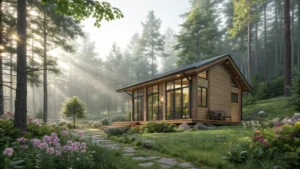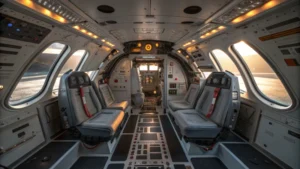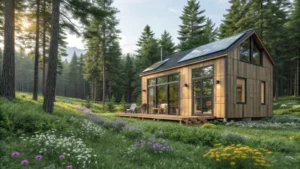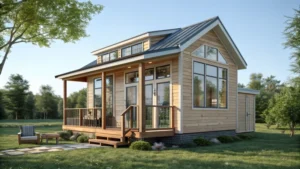%[A modern prefabricated home in a lush green environment](https://cozehouse.com/wp-content/uploads/2024/12/modern-prefabricated-home-india.webp "Modern Prefabricated Home in Nature")
Thinking about a prefabricated home in India? It could be your dream space without breaking the bank!
**The cost of a prefabricated home in India ranges from ₹10,00,000 to ₹1,00,00,000 ($12,000 to $120,000 USD), depending on size, design, and materials used. Basic models start at around ₹10,00,000 for smaller homes, while luxury versions can exceed ₹1,00,00,000 due to premium features.**
When I first started exploring prefabricated homes in India, I was intrigued by how versatile and cost-effective they could be. These homes aren't just about slashing prices—they offer a whole new lifestyle option. From basic models to luxurious designs, each price bracket comes with its own set of perks and possibilities. As I dug deeper, I found that factors like size and material choice really influence the final cost. Whether you're looking for a simple starter home or a lavish retreat, prefabs offer flexibility and style that can match any need or budget. It's fascinating to see how a prefabricated home might just be the ideal solution for those seeking quick construction and modern design without compromising on quality.
Prefab homes in India start at ₹10,00,000.True
Basic prefabricated homes in India are priced from ₹10,00,000.
Luxury prefab homes in India cost under ₹50,00,000.False
Luxury prefabricated homes can exceed ₹1,00,00,000 due to premium features.
## What Factors Influence the Cost of Prefabricated Homes in India?
When I first stumbled upon prefabricated homes, I was intrigued by their promise of affordability and eco-friendliness.
**The cost of prefabricated homes in India depends on factors like size, materials, design complexity, location, and transportation. Customization options and local regulations are also key influences.**
%[A modern prefabricated home in an Indian landscape with large windows and greenery](https://cozehouse.com/wp-content/uploads/2024/12/modern-prefabricated-home-indian-landscape.webp "Modern Prefabricated Home")
Understanding these variables can make all the difference when you're planning your dream home or investment project.
### Size and Design Complexity
The size of the prefabricated home directly impacts the cost. Larger homes require more materials and labor, increasing the price. I remember when I was contemplating the size of my own modular home project, realizing that a larger space naturally meant more materials and labor costs. Picture this: you're dreaming of a spacious open floor plan or a chic rooftop deck. These unique features not only add to the charm but also require specialized craftsmanship, inevitably nudging up the price tag.
### Materials Used
Choosing materials is like being a kid in a candy store. The range is vast—from budget-friendly steel and concrete to luxurious high-quality timber and energy-efficient glass. It's fascinating how opting for premium materials can elevate the entire look and feel of a home, but it’s something to weigh carefully against your budget.
| Material Type | Cost Influence |
|-------------------|----------------------|
| Basic Materials | Lower Costs |
| Premium Materials | Higher Costs |
[Learn more about sustainable materials](https://elemental.green/18-inexpensive-sustainable-homes-almost-anyone-can-afford/)[^wfitcophii-1].
### Location and Transportation
When we decided on a remote location for one of our projects, we soon discovered how delivery costs could skyrocket due to logistical hurdles. Plus, the local climate dictated our material choices, impacting the overall expense. The geographical location where the home is being delivered can impact transport costs. Remote areas may incur higher delivery fees due to logistical challenges.
### Customization Options
One of the joys of prefabricated homes is customization. However, I learned that adding custom finishes, integrating smart home tech, or installing eco-friendly features can significantly hike up the costs. It’s a balance between fulfilling your vision and managing expenses.
[Explore customizable options](https://www.loomcraftsprefab.com/)[^wfitcophii-2].
### Local Regulations
Navigating local building codes was an eye-opener for me. Ensuring compliance not only required time and resources but also influenced material selection and construction methods. Compliance with local building codes and regulations can add to costs by requiring necessary permits and ensuring adherence to safety standards.
[Understand local building codes](https://www.prefab-house.com/a-news-is-container-house-legal-in-india.html)[^wfitcophii-3].
Larger prefabricated homes in India cost more due to materials.True
Larger homes require more materials and labor, increasing the overall cost.
Remote locations reduce the transport costs of prefab homes.False
Remote areas increase delivery fees due to logistical challenges.
[^wfitcophii-1]: Discover how sustainable materials can enhance eco-friendliness while potentially affecting costs.
[^wfitcophii-2]: Find out how various customization choices can influence the final price of your prefab home.
[^wfitcophii-3]: Understand how adhering to local building codes can impact construction costs.
## Are Prefabricated Homes a Good Investment Compared to Traditional Homes?
When it comes to building a home, I've always found the idea of prefabricated homes intriguing. But are they truly a smart investment compared to traditional homes? Let’s dive in and see what makes them stand out or fall short.
**Prefabricated homes can be a good investment due to their lower initial costs and faster construction times, offering eco-friendly benefits. However, it's essential to weigh factors like resale value, location, and build quality to determine their overall worth against traditional homes.**
%[A modern prefabricated home beside a traditional brick house in a suburban setting.](https://cozehouse.com/wp-content/uploads/2024/12/modern-prefabricated-home-and-traditional-brick-house.webp "Modern vs Traditional Homes")
### Cost Comparison: Prefab vs. Traditional Homes
I remember the first time I heard about prefabricated homes. It was during a conversation with a friend who had just built one and was raving about the savings and efficiency. Prefabs often come with lower initial costs compared to traditional homes because of their [streamlined manufacturing](https://www.msuite.com/10-benefits-of-prefab-in-construction/)[^aphagictth-1] processes and reduced labor expenses. They can be about 10-25% cheaper, which is quite appealing.
| Type of Home | Estimated Cost | Features |
|-------------------|-------------------|------------------------------------|
| Basic Prefab | $12,000-$25,000 | Compact size, energy-efficient |
| Mid-Range Prefab | $25,000-$60,000 | Custom designs, eco-friendly |
| High-End Prefab | $60,000-$120,000 | Luxury features, premium materials |
### Resale Value and Market Trends
The resale value was something I worried about when considering a prefab. Some [studies](https://timberhut.com/resale-value-of-prefab-homes/)[^aphagictth-2] suggest that modern prefabs hold value well thanks to quality improvements and sustainable designs. Yet, this varies by region and the market perception can be quite different. Location desirability and local real estate trends play significant roles in resale potential.
### Durability and Longevity
The idea of having my home constructed in a controlled environment is comforting. Prefabs tend to experience fewer delays and often adhere to higher quality standards, potentially translating into longer-lasting structures. However, traditional homes still seem to carry the perception of being more robust and enduring investments.
### Eco-Friendly Advantages
Given the rising demand for eco-friendly living spaces, prefabs have their charm. Many are designed with [sustainable materials](https://pacificmobile.com/modular-construction/10-sustainable-materials-for-eco-friendly-modular-structures/)[^aphagictth-3] and energy-efficient technologies. This not only helps reduce utility costs but also aligns with the increasing environmental consciousness among buyers like myself.
In summary, while prefabs offer cost savings and green benefits, their long-term investment potential heavily depends on factors like resale value and market acceptance. Personally, I'd recommend consulting with local real estate experts to understand regional preferences and trends before making a decision.
Prefab homes are 10-25% cheaper than traditional homes.True
Prefab homes have lower costs due to efficient manufacturing and less labor.
Traditional homes are more eco-friendly than prefab homes.False
Prefab homes often use sustainable materials and energy-efficient designs.
[^aphagictth-1]: Discover how streamlined manufacturing processes in prefabrication reduce costs and lead times.
[^aphagictth-2]: Explore how resale values for prefab homes are evolving in various real estate markets.
[^aphagictth-3]: Learn about the sustainable materials used in prefab homes and their environmental impact.
## How Do Prefabricated Home Brands Like Tata Compare?
Remember the first time you heard about prefabricated homes? I was skeptical too, but then I discovered brands like Tata and everything changed.
**Tata's prefabricated homes are a standout in the market thanks to their affordable pricing, sleek designs, and a solid track record for quality. Whether you're after budget-friendly or luxury options, Tata delivers reliability with a modern touch, making them a top choice for many buyers.**
%[A modern prefabricated home with large glass windows and a flat roof in a green landscape.](https://cozehouse.com/wp-content/uploads/2024/12/modern-prefabricated-home-tata.webp "Modern Prefabricated Home by Tata")
### Pricing and Market Position
Let me take you back to when I was first researching prefabricated homes for a project. I quickly realized that pricing is a huge factor. Tata offers something for everyone, with basic models starting around ₹10,00,000. This is quite competitive if you peek at what other brands charge. I remember doing a quick [price analysis](https://www.alibaba.com/showroom/tata-prefabricated-houses.html)[^hdphbltc-1] myself and finding Tata positioned as a cost-effective option without skimping on quality.
| Type | Tata Price Range | Competitors Price Range |
|-------------------|---------------------|----------------------------|
| Basic | ₹10-₹20 lakhs | ₹12-₹22 lakhs |
| Mid-range | ₹20-₹50 lakhs | ₹25-₹55 lakhs |
| High-end | ₹50 lakhs-₹1 crore | ₹55 lakhs-₹1.2 crores |
### Design and Customization
When I first saw the design flexibility that Tata offered, it felt like discovering a whole new world. Imagine designing a home that can fit your specific needs—whether you're dreaming up a [luxury resort](http://www.nestin.co.in/)[^hdphbltc-2] or want something eco-friendly. With so many finishes, layouts, and materials to choose from, it's no wonder why Tata is a go-to for those wanting personalized solutions.
### Quality and Sustainability
Sustainability is not just a buzzword; it's a lifestyle choice I aim to incorporate in every project. Tata uses eco-friendly materials and energy-efficient systems, which really aligns with my goal of creating environmentally conscious spaces. Their homes are not only built to last but are also kind to the planet. While other brands might offer similar features, Tata's longstanding reputation adds an extra layer of trustworthiness that I find comforting.
### Brand Reputation and Customer Support
In the world of construction, reputation is everything. Tata has been a reliable name for decades, and their after-sales support is just another reason they stand out. Whether it's [installation guidance](http://www.nestin.co.in/nest-in-blog/complete-guide-to-prefabricated-villa)[^hdphbltc-3] or maintenance packages, they provide comprehensive services to ensure a smooth homeowner experience.
### Innovations in Prefabricated Housing
Every now and then, I get excited about the innovations in prefabricated housing. Tata's investments in [R&D](http://www.nestin.co.in/)[^hdphbltc-4] mean they're always at the cutting edge of technology. From smart home integrations to modular designs that cater to modern lifestyles, Tata keeps its competitive edge sharp in this ever-evolving market.
Tata's basic prefabricated homes start at ₹10 lakhs.True
The context states that Tata's basic models start at approximately ₹10,00,000.
Tata offers the highest priced prefabricated homes in the market.False
The context shows competitors have higher price ranges than Tata.
[^hdphbltc-1]: Explores detailed pricing comparisons between Tata and other brands, helping buyers make informed decisions.
[^hdphbltc-2]: Offers insights into Tata's luxury prefab options, showcasing their appeal to high-end buyers.
[^hdphbltc-3]: Provides guidance on Tata's installation process, highlighting ease and efficiency for prospective buyers.
[^hdphbltc-4]: Unveils Tata's latest innovations in prefabricated housing, emphasizing their commitment to modern solutions.
## What Are the Pros and Cons of Choosing a Prefabricated Home?
Curious about prefabricated homes? Dive into the world of cost-effective, sustainable living, and explore the potential challenges like customization limits and zoning hurdles.
**Prefabricated homes offer affordability, quick construction, and eco-friendly features, but may present challenges in customization and compliance with local zoning laws. Carefully weighing these pros and cons can help you make an informed decision.**
%[A modern prefabricated home in a natural setting](https://cozehouse.com/wp-content/uploads/2024/12/modern-prefabricated-home.webp "Modern Prefabricated Home")
### The Upsides of Prefabricated Homes
**Cost Efficiency**: When I first considered prefabricated homes, the idea of saving on costs immediately caught my attention. Imagine significantly reducing those hefty construction expenses! In a controlled [manufacturing environment](https://www.buildgp.com/blog/the-power-of-prefab-controlling-project-quality-and-cost)[^watpacocaph-1], waste is minimized, which means less out of pocket compared to traditional builds. Labor costs are notably lower since much of the work is done off-site.
| Aspect | Prefab Homes | Traditional Homes |
|-------------------|--------------|-------------------|
| Labor Costs | Lower | Higher |
| Material Waste | Minimal | Significant |
| Construction Time | Faster | Slower |
**Quick Setup**: The speed at which these homes go up is another major draw. With parts pre-made, the assembly process is a breeze, especially beneficial if you're eager to settle in quickly or in urgent situations like disaster relief. It's almost like seeing your dream house unfold before your eyes in no time!
**Sustainability**: On top of that, prefab homes often champion sustainability. Many incorporate eco-friendly materials and energy-efficient technologies, which really resonates with my desire to reduce my carbon footprint. It's a choice that feels good both personally and environmentally.
### Potential Downsides of Prefabricated Homes
**Limited Customization**: However, there are a few bumps on this road. One of the challenges I faced was limited customization. Sure, there are many designs available, but for someone with a specific architectural vision, it might feel a bit restrictive.
**Zoning and Compliance Issues**: Then there's the matter of zoning and compliance issues. Depending on where you live, the regulations can vary significantly for prefab structures. I had to jump through several hoops to secure permits and ensure my home met local building codes.
**Resale Value**: Resale value is another consideration. While it's improving, prefab homes sometimes lag behind traditional ones in this regard. It's often more about perception than actual quality or durability.
Navigating these challenges requires thorough research. I made sure my chosen prefab model not only met my needs but also aligned with [local regulations](https://www.manufacturedhousing.org/news/get-the-facts-on-zoning/)[^watpacocaph-2]. Partnering with experienced suppliers can also alleviate some of the potential issues during the buying and installation process.
Prefabricated homes are more cost-efficient than traditional homes.True
Prefab homes reduce costs due to minimal material waste and lower labor expenses.
Prefabricated homes always have higher resale value than traditional homes.False
Resale value can be lower due to public perception, not quality or durability.
[^watpacocaph-1]: Understand how prefabrication minimizes waste and reduces labor costs, making it a cost-effective housing solution.
[^watpacocaph-2]: Learn about zoning requirements for prefab homes to ensure compliance with local building codes before purchase.
## Conclusion
Prefabricated homes in India range from ₹10,00,000 to ₹1,00,00,000, offering cost-effective and customizable options for various budgets while considering factors like materials and location.










